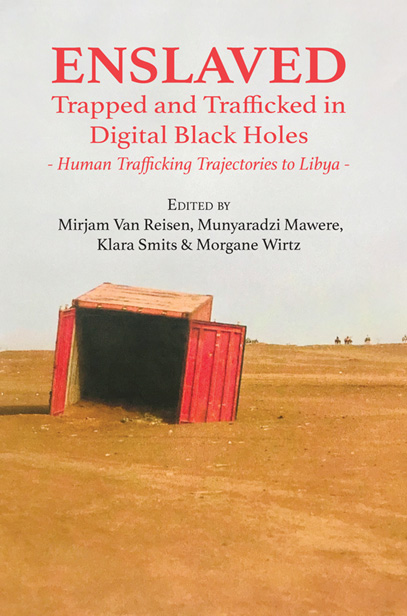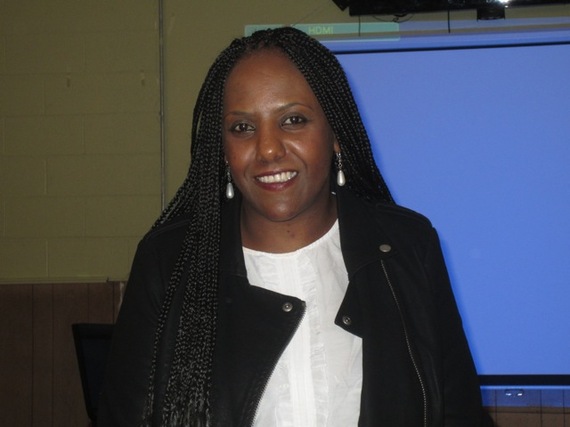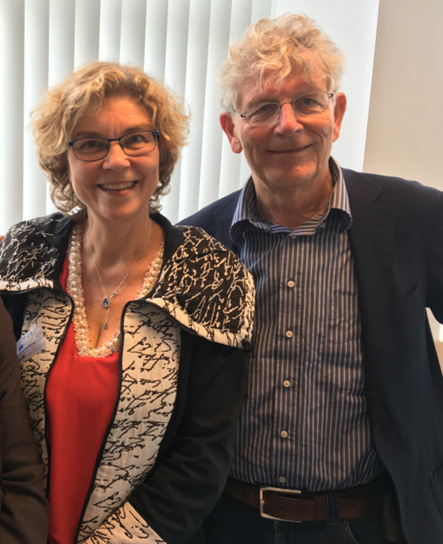Prof. Mirjam van Reisen: a Tulip in a field of weeds
Prof. Mirjam van Reisen has a long history in activism behind her. Mirjam supported survivors; exposed the unlawful activity to world media; petitioned EU leaders to introduce anti-trafficking laws; laboured to bring traffickers to face justice; and challenged rogue governments for their roles in trafficking.

I always marvelled at Mirjam’s overall knowledge, her grasp of the human trafficking crisis, her composure, and her indefatigable nature in pursuing her advocacy work. She campaigned hard to draw attention to victims of human rights violations from the Horn of Africa. In fact, she dealt with the predicaments of victims of human trafficking from the region for over two decades.
Slowly, I came to understand that she somehow draws energy from the world around the trafficked. Truly, a tough and draining experience! I know now it is a life changing experience when one seriously considers advocating for the abused Eritrean youth who are shoved into blind alleys by their ubiquitous circumstances in quest of that elusive freedom.
Driven by desperation the Eritrean youth break loose to face a destiny fraught with danger. The insecurity the refugees face extends far beyond the pain and adversities they live through in Eritrea. “Imagine the uncertainties the youth face once they leave the comfort of home life and are ping-ponged from one trafficker to another” says Mirjam. “Imagine embarking on a solitary and treacherous journey that leads to gruesome ordeals”, she adds.

A book which deals with the plight of Eritrean refugees has been published this year under the title of Enslaved: Trapped and Trafficked in Digital Black Holes: Human Trafficking Trajectories to Libya. It is edited by Prof. Mirjam van Reisen and three of her colleagues.
The book which is published by Langaa RPCIG contains 792 pages that are divided into 17 chapters. It provides a detailed insight into the condition of circa 200.000 refugees enslaved and trafficked in Libya during 2017-2021. And the cumulative value of the trafficking trade for that period is estimated at over 1 billion USD.
Basically, the book argues that the refugees are caught in ‘black holes’ in the digital landscape – both in and out of Eritrea. It painstakingly depicts a vivid picture of how the Eritrean youth are targeted by ICTs and Internet connectivity that are strictly controlled by the government; and once they leave Eritrea how they are forced to depend on smugglers and traffickers in order to start, if they are lucky, a new life in the West.
First, who is Prof. Mirjam van Reisen?
Let’s start from an atypical angle – from the ‘Tulip’ viewpoint.
One can say that Prof. Mirjam van Reisen, having attained excellence in her field of studies, is an excellent source of information regarding symbolism of the tulip, a flower that blooms in spring in almost every colour under the sun.
Enthusiasts of this special flower say that its varieties and colours are a breath of fresh air which we all need after the dreary months of winter. To Mirjam, the flower symbolises new life.
To shed light on her theory concerning ‘new life’, I asked her to share stories about the early years with me - when she was growing up in a small village of Stiphout, located in the south of the Netherlands.
“I come from a very large family” Mirjam begins to describe her upbringing. “My father had 11 brothers and 2 sisters. I am the eldest of four siblings. My paternal grandfather was a farmer who farmed bulbs” she recalls.
“I love how the tulip sits in soggy clay throughout the dark months of winter and still manages to survive” she slightly strays. “And then, at the arrival of spring, the bulb produces a colourful flower that comes out to greet the sunlight” she adds. “In spring one only has to board a train or pick up a bicycle to watch the tulips in all their glory in rural fields of the Netherlands” says Mirjam with a touch of pride.
Mirjam goes on to clarify how her grandfather produced a dark blue tulip she used to admire as a child. “In each bulb, if you open it, you find a small white flower hidden inside” she says. “It only acquires its unique beauty when the soggy clay releases its grip, to allow the bulb to open up and push the flower up to greet the sun. The transformation is quite enthralling” avows Mirjam.
We will come back to why Mirjam associates the beauty of her special tulip with the lives of Eritrean refugees. For now let’s look into her activist and professional life.
The other side of Mirjam
Prof. Mirjam van Reisen has a long history in activism behind her. Mirjam supported survivors; exposed the unlawful activity to world media; petitioned EU leaders to introduce anti-trafficking laws; laboured to bring traffickers to face justice; and challenged rogue governments for their roles in trafficking.
Who would forget the headlines that suddenly appeared on world media that "Eritreans were being tortured in Egypt's Sinai for ransom”, which sent tremors throughout Eritrean communities all over the world? Basically, the world came to learn that traffickers were coercing Eritreans into paying them an exorbitant sum of money to have their loved ones released. Yes, who would have thought that Eritreans were being beaten, tortured and electrocuted until their families paid thousands of dollars for their release?
The other revelation that sent shockwaves among Eritreans was to do with the fact that Eritreans themselves were engaged in trafficking their own brothers and sisters.
When her report on the evils of trafficking came out in 2012 it caught the imagination of the general public and various international institutions.
What Prof. Van Reisen did was connect the dots between the cause and effect of trafficking. In other words, she showed what was happening inside Eritrea, why Eritreans were fleeing and falling in the hands of traffickers.
The report also caught the attention of the PFDJ (government party) and its supporters who were up in arms to attack Mirjam for exposing the government’s role in the affair. The conscientious Eritreans suffered from overwhelming feelings of shame while the deniers were completely at odds with the way trafficking of young Eritreans was linked to the regime.
It is to be remembered that the government issued a litany of denials; and its supporters simply followed suit.
How did Mirjam Embark on Researching Human Trafficking?
“I started this work because of Fr. Mussie Zerai and Meron Estefanos” says Mirjam.
Fr. Mussie Zerai is a Roman Catholic priest known for his work with migrants crossing the Mediterranean Sea from North Africa to Europe during the European migrant crisis.

Meron Estefanos is a journalist, human rights activists who campaigned single-mindedly on behalf of Eritrea’s ‘boat people’. And in the process, she exposed the link between the draconian ways the Eritrean regime employs in treating its citizens and how the youth were ending up becoming victims of trafficking.
At a conference in 2009, Fr. Mussie gave testimony at a conference on Eritrea in Brussels. “We simply couldn’t believe what we heard at the conference”, says Mirjam.
After the conference, Meron took it upon herself to investigate what was really happening to the victims of trafficking. Mirjam gives Meron a lot of credit for doing a lot of important groundwork for the project.
“At some point we came to realise that the predicament was so relentless that it needed academic intervention to unravel. After primarily researching the situation of human trafficking for ransom in Sinai, we moved on to investigate how it was tied up with the situation in Libya” says Mirjam.
“But we found out the work was hard. We ran across obstacles in every junction. The groups of youngsters we researched were in remote and isolated areas. We were confronted with secrecy in every step of the way; and the traffickers did their utmost to conceal their illegal activities. Basically, it took a lot of time to research the subject matter and collect solid evidence” explains Mirjam.
The Public Response
When Eritreans came to realise that their brothers and sisters were fleeing Eritrea in droves and crossing the desert from Egypt to Israel under hazardous conditions, the majority were stunned by the disclosure; others responded to Mirjam’s findings warily. There were groups who reacted rather wildly – as if her conclusion were fake news.
Government supporters, particularly those deluded by misplaced loyalty to the president (instead of the truth) and flawed sense of narrow regionalism, tried to muddy the waters.
For instance, a certain Amanuel Biedemariam from ‘Tesfa News’, a government affiliated website, wrote an article to criticise Mirjam for her work rather unfittingly. His article was not based on reason and straight forward facts; but it lacked balance and consistency. He wrote, without repeating his crude and imprudent phrases, “Dr Van Reisen is using the ‘Lampedusa tragedy’ to make a political case in order to bolster her campaign for her anti-Eritrean agenda.”
It is worth mentioning that he failed to show the nature of her ‘agenda’. Why would she do that? What is there to gain for a fully accredited academic by fabricating falsehoods about Eritrea, as he implied?
It is to be remembered that in 2013 a boat carrying migrants from Libya to Italy sank off the Italian island of Lampedusa, killing 366 migrants, many of whom were Eritreans. The image of Lampedusa tragedy has remained etched on our memories ever since.
Mr Biedemariam, the critic, made no mention of why Eritrean boat people chose to use a people-smuggling route fraught with danger while fleeing. Moreover, he did not mention how and why ‘Fanus’, a Lampadesa survivor, fled Eritrea and was kidnapped while crossing the Sahara on the way to Libya. Fanus’ story is available in the public domain. The question that arises is why Prof Van Reisen would misconstrue the troubles Fanus’ (and her likes) went through?
I admit I read Amanuel Biedemariam’s unwarranted critique in utter perplexity. Though we Eritreans possess a wonderful trait that others lack – patriotism – many a times we tend to exaggerate our love for Eritrea to a point of turning it into our Achilles heel. Mr Biedemariam’s standpoint confirmed to me that we, rather unnecessarily, waste precious energy by ‘circling the wagon’ … or defending the indefensible rather misguidedly.
Mirjam, the writer/academic
Prof. Mirjam van Reisen is a prolific writer/academic and well known within Eritrean communities. She is Prof of International Relations, Innovation and Care at Tilburg University, Faculty of Humanities and Digital Sciences, Department of Culture Studies.
From 2012 – 2021 she was a member of the Dutch Government Advisory Council on International Relations and chair of the committee on development cooperation.
Prof. Dr. Mirjam van Reisen holds the chair FAIR Data Science at the Leiden University as well.
She is the Founding Director of the Europe External Policy Advisors based in Brussels (EEPA). She received the Golden Image Award from President Ellen Johnson-Sirleaf of Liberia.
BTW, the Golden Image Award is a national meritorious award bestowed on individuals or organizations that have made selfless contribution to peace and humanity nationally or internationally.

Prof van Reisen is the author of the following books:
- Van Reisen, M., Smits, K. (2018). Eritrea en Eritrese Vluchtelingen. Centraal Orgaan opvang Asielzoekers (COA): the Netherlands.
- Buck, KD. & Van Reisen, M. (eds.) (2017). Eritrea: from liberation to oppression. Hamburg: EMW.
- Buck, KD. & Van Reisen, M. (eds.) (2015). Eritrea: Von der Befreiung zur Unterdrückung. Hamburg: EMW.
- Van Reisen, M. (ed.) (2014). Women’s leadership in peace building: Conflict, Community and Care. Africa World Press Inc. & The Red Sea Press Inc.
- Van Reisen, M., Estefanos, M. & Rijken, C. (2014). The Human Trafficking Cycle: Sinai and Beyond. Nijmegen: Wolf Legal Publishers.
- Van Reisen, M., Estefanos, M. & Rijken, C. (2012). Human Trafficking in the Sinai: Refugees between Life and death. Nijmegen: Wolf Publishers.
- Borgman, E. & Van Reisen, M. (eds.) (2012). De Verbeelding van Marga Klompé. Perspectieven op de Toekomst. Kampen: Klement.
- Borgman, E., Plessius, I. & Van Reisen, M. (eds.) (2012). In Liefde en Rechtvaardigheid. Het dagboek van Marga Klompé 1948 – 1949. Hilversum: Verloren.
- Van Reisen, M (2009). Window of Opportunity: EU Development Cooperation after the End of the Cold War. Africa World Press Ltd and Europe External Policy Advisors (EEPA).
- Van Reisen, M. (1999). EU Global Player: The North-South Policy of the European Union. International Books: Utrecht.
Prof van Reisen is also the editor of the following books:
- Human Trafficking and Trauma in the Digital Era: The On-going Tragedy of the Trade in Refugees from Eritrea.
- Roaming Africa: Migration, Resilience and Social Protection.
- Mobile Africa: Human Trafficking and the Digital Divide
- Women’s Leadership in Peace Building: Conflict, Community and Care.
As mentioned above, the most recent book she co-edited is called: Enslaved: Trapped and Trafficked in Digital Black Holes: Human Trafficking Trajectories to Libya
The other co-editors are Munyaradzi Mawere, Klara Smits and Morgane Wirtz.
To recap what has already been mentioned in the above paragraphs, the book is about Eritreans who are caught in ‘black holes’ in the digital landscape – both in and out of Eritrea. It shows how their legal status inside Eritrea is defied by various limitations; and once in Libya – how their illegal status poses insurmountable problems that restrict them from leading a normal and peaceful existence.
“Their illegal status prevents them from accessing protection and makes them targets for exploitation”, argues the book.
Moreover, it asserts that “as many fall victim to human trafficking for ransom, the policies of the EU exacerbate their situation by trapping them in a human trafficking cycle.”
According to Mirjam, in Libya, the refugees are “labelled with a digital code, and they are transported through a series of obstacles in which their access to digital technologies and connectivity is highly controlled” she clarifies.
“Not only are they tortured, abused, extorted and subjected to sexual violence, many, if they make it to the Mediterranean Sea, they risk being intercepted and returned to Libya or simply die at sea” she affirms.
This detailed ethnographic study identifies the routes, modus operandi, organisation, and key actors involved in the human trafficking for ransom of refugees and migrants, who are desperately in need of protection. The book is part of the GAIC Research Network and African studies series published by Langaa RPCIG and makes an important contribution to the literature on human trafficking, migration studies, African studies, modern slavery, social protection and governance.
Mirjam and the Eritrean youth
As mentioned above, many Eritreans associate Mirjam with the research she conducted on human trafficking in general, and the impact of her research on their lives, in particular.
However, one needs to mention that Mirjam was set to be on a collision course with misinformed government supporters, who happened to be refugees themselves, and found it hard to digest the fact that the Eritrean regime was the main culprit in driving out the youth from Eritrea.
Eritreans, according to UN reports of the time, were fleeing the country in the thousands – around 5000 youngsters a month. Those who deny the reality on the ground (in Eritrea proper) could neither comprehend nor accept how she concatenates the draconian measures the government employs under the guise of national service, the exodus of youngsters that ensues, and the abuse they face in the hands of traffickers.
Easing the plight of Eritrean Refugees in Europe?
One does not have to dig deep in search of what Mirjam contributed to the wellbeing of Eritrean refugees whose number amount to hundreds of thousands.
Eritrea witnessed the highest number of its citizens going into exile since its independence. One would expect, under normal circumstances, independence would usher in stability and restrict the exodus of its people considerably. On the contrary, independence set in motion unimaginable mass departures - more than previous eras put together – the Italian colonisation period, the British military administration, the Emperor Haile Selassie as well as the Derg (military junta) occupation eras.

The exodus became the principal contradiction that Eritrea has ever experienced since its independence in 1991.
Mirjam and her fellow campaigners have been advocating the plight of Eritrean boat-people. She is credited with submitting reliable information to regional or international human rights mechanisms, including the other special rapporteurs of the United Nations Human Rights Council and treaty bodies. Increasingly, the work of human rights defenders is mixed, with the focus being on local and national human rights issues, but with defenders making contact with regional and international mechanisms which can support them in improving human rights in their countries.
Mirjam, together with other human rights defenders, is doing her best to bring traffickers to face justice. It is to be remembered how Kidane Zekarias Habtemariam, the notorious human trafficker from Eritrea who is accused by authorities in the Netherlands of leading a criminal syndicate that employed violence and intimidation, including torture and rape, to traffic and exploit people fleeing the Horn of Africa. Well, Kidane is in police custody now; and as a result, the world of the trafficked is in a safer space.
Although Mirjam became a victim of the Eritrean regime’s propaganda campaign, she did not bend to pressure but remained true to herself. In fact, she managed to channel the voices of the trafficked on the world stage. In view of that, the asylum cases of tens of thousands of Eritreans were rightly tagged to receive the attention they deserve.
Before I concluded my dialogue with Mirjam, I reminded her to explain why the tulip symbolises ‘new life’ and how it relates to the life of a migrant.
“One of the biggest subject matter I studied in my life and feel close to is that of the migrants whose survival, as far as I am concerned, was beset by evil forces inside and outside Eritrea rather repeatedly” she started to explain.
“Allow me to refer to the migrant community as my ‘my Eritrean family’ because they have been my source of energy and inspiration” says Mirjam self-effacingly.
“These young people have demonstrated to me again and again they have courage to leave their parents, their communities, their friends and neighbourhoods behind in search of a better life abroad. They run away from the stifling open ended national service, only to run into uncharted territories where the thugs roam around-the-clock and rule their worlds. That I found distressing.
“Their parents are equally trapped by the plight of their loved ones because they are made to pay the price the thugs demand for the release of their captured children. I feel their pain. I share their pain” Added Mirjam.
“Among the migrants there are those with undefeatable traits who survive the arduous journeys and reach the Mediterranean shores” she mused. “I watched many rise from the ashes of their old world to rebuild their lives in such a hostile new world” she added. Mirjam said she often wondered about such indomitable souls. In fact, she admired them for making it in this world against all odds.
“Like the tulip that sits in soggy clay throughout the dark months of winter and still manages to survive when it greets the sun…”
I thought about her symbolism after I finished writing the story. Then I asked myself how she could draw that comparison when she herself is the ‘tulip in a field of weeds’.


![[AIM] Asmarino Independent Media](/images/logo/ailogo.png)